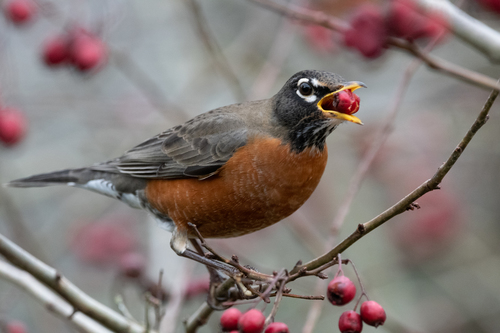
American Robin
The American Robin (Turdus migratorius) is a ubiquitous and beloved songbird found throughout North America. Known for its cheerful song and bright red breast, it's a familiar sight in gardens, parks, and woodlands. The robin plays a vital ecological role as a seed disperser and consumer of invertebrates, contributing to the health of various ecosystems. While not typically considered culturally significant in the same way as some other birds, its association with springtime and renewal has made it a popular symbol in folklore and literature.
23-28 cm
Length
31-41 cm
Wingspan
Least Concern
Conservation Status
Distribution
The American Robin has a wide range, breeding from Alaska and Canada south to Mexico and the Gulf Coast. It is migratory, with northern populations moving south for the winter. They can be found at elevations from sea level to above 10,000 feet.
Lifespan
The average lifespan in the wild is about 2 years, although some individuals have been recorded living over 10 years.
American Robin's Habitat
Habitat Types
Forests, Woodlands, Parks, Gardens, Fields, Suburban areas
Climate Zones
Temperate, Subarctic, Subtropical
Adaptations
American Robins are highly adaptable to various habitats, thriving in both natural and human-altered environments. Their ability to utilize a diverse range of food sources contributes to their success.
Variations
Seven subspecies of the American Robin are recognized, differing slightly in size and plumage coloration. These variations are often subtle and related to geographic location.
Appearance
Breeding Plumage
Plumage is generally consistent year-round, although it may appear slightly duller in the non-breeding season.
Seasonal Feather Changes
Minor variations, mainly in the intensity of coloration.
Sex Based Plumage Differences
Males typically have a darker head and brighter red breast than females. Females and juveniles have paler breasts.
Notable Features
Bright red-orange breast, Dark gray to black head and back, White eye-ring (broken), Yellow bill with a dark tip
Diet and Feeding
Primary Foods
Earthworms, Insects, Fruits, Berries
Foraging Behavior
American Robins often forage on the ground, hopping and running, then pausing to look and listen for prey. They are known for pulling earthworms from the soil.
Specializations
They have excellent eyesight and hearing, which aids in locating prey beneath the soil surface.
Seasonal Diet Variations
Their diet shifts with the seasons. In spring and summer, they primarily eat earthworms and insects, while in fall and winter, they consume more fruits and berries.
Behavior
Social Structure
American Robins are generally solitary or found in pairs during the breeding season. In the non-breeding season, they may form large flocks, especially during migration and at roosting sites.
Communication
Complex vocalizations, including a cheerful 'cheerily, cheer up, cheer up, cheerily, cheer up' song, Alarm calls, such as a sharp 'peek' or 'tut', Contact calls between flock members
Migration
Many populations are migratory, traveling south in the fall and returning north in the spring. Migration is often triggered by food availability and weather conditions.
Territorial or Group Behaviors
During the breeding season, males are highly territorial, defending their nesting area from other robins. Outside of breeding, they are more tolerant of each other.
Conservation
Threats
Habitat loss, Pesticide use, Collisions with buildings and vehicles, Predation by cats and other animals
Protection Programs
Migratory Bird Treaty Act (protection in the US)
Local National Laws
Protected under various state and federal laws in the United States and Canada.
Population Trend
Stable
Population Estimates
Estimated to be around 370 million individuals.
Interesting Facts
American Robins can produce multiple broods in a single breeding season.
This allows them to maximize reproductive success, especially in favorable conditions.
They are one of the earliest songbirds to sing in the morning.
Their dawn chorus is a familiar sound in many areas.
Robins often use mud to reinforce their nests.
This helps create a sturdy and durable structure.
American robins sometimes become intoxicated.
This happens when they consume overripe berries that have begun to ferment.
Faqs about American Robin
What do I do if I find a baby robin?
If the bird is injured or in immediate danger, contact a local wildlife rehabilitator. If it appears healthy and is feathered, it's likely a fledgling and its parents are nearby. It's best to leave it alone.
Why do robins hop instead of walk?
Hopping is an efficient way for them to move across the ground while searching for food. It allows them to quickly change direction and scan for prey.
Are American Robins attracted to bird feeders?
While they may occasionally visit feeders, they prefer to forage on the ground. Offering mealworms or fruit may be more successful in attracting them.
Do American Robins return to the same nest?
While American Robins do not typically use the exact same nest in subsequent years, they will frequently build a new nest near a prior nesting location.
Copyright @ Nature Style Limited. All Rights Reserved.
 English
English